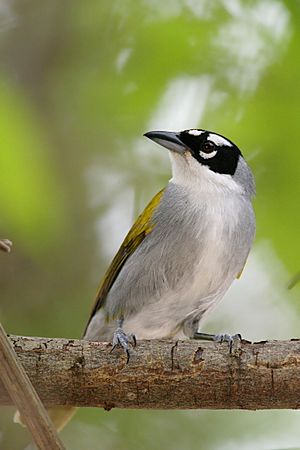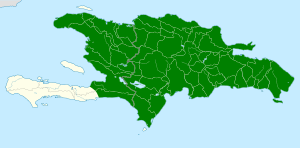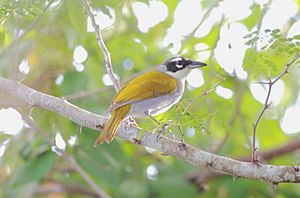Black-crowned tanager facts for kids
Quick facts for kids Black-crowned tanager |
|
|---|---|
 |
|
| Conservation status | |
| Scientific classification | |
| Genus: |
Phaenicophilus
|
| Species: |
palmarum
|
 |
|
| Range in green | |
| Synonyms | |
|
Turdus palmarum Linnaeus, 1766 |
|
The black-crowned tanager (Phaenicophilus palmarum) is a cool bird found only on the island of Hispaniola. This island is shared by two countries: Haiti and the Dominican Republic. It belongs to a special bird family called Phaenicophilidae, which are also known as Hispaniolan tanagers.
Contents
About Its Name
The black-crowned tanager got its scientific name, Phaenicophilus palmarum, from a famous scientist named Carl Linnaeus in 1766. The name palmarum is Latin and means "of palm trees," which makes sense because these birds are often found near palms!
This bird is closely related to the grey-crowned tanager. For a long time, scientists thought these birds belonged to the "true" tanager family (Thraupidae). But in 2017, they were moved to their own special family, Phaenicophilidae, because they are unique to Hispaniola.
What It Looks Like
The black-crowned tanager is about 17 to 18 centimeters (7 inches) long. It weighs around 24 to 32 grams (about 1 ounce). Both male and female birds look very similar.
This bird has a strong, pointed beak. The top part of its beak is black, and the bottom part is blue-gray with a black tip. Its head is mostly black. It has a white patch above its beak and a bigger white patch above its reddish-brown eye. There's also a thin white line just below its eye.
The back of its neck is gray. The rest of its upper body and tail are a bright yellowish-olive color. Its throat and the middle of its chest are white. The sides of its chest, belly, and feathers under its tail are gray. Young birds have a dusky gray head instead of black, and their throat might look a bit yellowish.
Where It Lives
The black-crowned tanager lives all over the main part of the Dominican Republic, including Saona Island. It also lives in Haiti, but not on the Tiburon Peninsula.
You can find this bird in almost every type of place on Hispaniola. It lives in many kinds of forests, from dry to humid ones. It also likes open areas and dense forests. You can even spot them in gardens and parks in towns and cities! They live from sea level up to about 2,500 meters (8,200 feet) high. However, they are most common below 2,000 meters (6,600 feet).
How It Behaves
Staying in One Place
The black-crowned tanager stays in the same area all year round. It does not migrate.
What It Eats
These birds usually look for food in pairs or with their family. They search for food at all levels of the forest, from the ground to the treetops. Sometimes, they even join groups of different bird species to find food together.
Their diet is mostly insects, making up about two-thirds of what they eat. The other third is fruit. They also drink a small amount of nectar from flowers.
Making a Home
The black-crowned tanager's breeding season is from April to June. They build a deep, cup-shaped nest in a tree or bush. Their nests are often found close to where people live.
They usually lay two or three eggs. The eggs hatch after about 10 days. The young birds are ready to leave the nest about 10 days after hatching.
Its Songs and Calls
The black-crowned tanager's song sounds different depending on where it lives. Generally, it's a mix of "squeaky notes that get louder, then softer and slower." Some birds also add harsh or buzzing sounds to their songs.
Their calls include a "nasal, buzzing 'pe-u'" sound. They also make a higher, sharper 'tseep' sound and a low 'chep' sound.
Its Status
The IUCN (International Union for Conservation of Nature) says the black-crowned tanager is a species of "Least Concern." This means they are not currently worried about it becoming endangered.
The bird lives in a large area, and even though we don't know the exact number of birds, their population seems stable. There are no big threats to them right now. They are common throughout their range and live in many protected areas. They have also learned to live well in places changed by humans.
See also
 In Spanish: Phaenicophilus palmarum para niños
In Spanish: Phaenicophilus palmarum para niños



